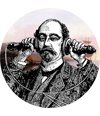A Brief History of the Digital Divide
Categories:
In the late 1970s and through all of the 1980s, unequal access to computers, the internet, and other forms of communication technology were seen as distant problems of a space-aged 21st century, if they were even thought of at all. In the 1980s and before, home computers were rare, expensive, and an esoteric pastime of enthusiasts. The internet was merely a pay-per-email facilitation device used by scholars and top government officials, and cordless phones were all the rage. The World Wide Web (WWW), multimedia computers, and fiber optic networks were all still under construction by computer technicians, engineers, and Al Gore.
It was not until the High Performance Computing Act passed on December 9, 1991 that mass internet access in the United States became a possibility. Aimed at bolstering the economy of the coming millennia, this bill proposed the creation of a high speed fiber optic network or what was called the National Information Infrastructure (NII). The bill’s effect on internet access was enormous. In the Fall of 1990 there were approximately 313,000 computers online throughout the United States, and by 1996 that number exploded to 10 million (Campbell-Kelly and Aspray 1996). Coupled with the introduction of the Mosaic web browser and the user-friendly Windows Operating System, fascination and wonder in the internet began to take off in American culture.
In the latter half of the 1990s the internet phenomena captured the imagination of many. The internet was what the railroad, the automobile, and the telephone were in their respective eras. The internet was a revolution, and it was going to change the economy, communication, society, and create an ever-shrinking planet. The internet was thought to be so full of possibilities that anyone who was left out of the revolution was doomed to a life of unconnected alienation, missed opportunity, and information poverty, while those basking in the glow of a Yahoo! flashing computer screen were thought to be sophisticated, chic, and informed individuals making a prudent choice by getting connected. Nobody, it was thought, should be deprived of the internet, its alternative plane of existence (cyberspace), and the endless possibilities of its infinite human network.
As the internet’s mystique grew, the National Telecommunications and Information Administration (NTIA) disseminated a report in July 1995 called Falling Through the Net: a Survey of the “Have Nots” in Rural and Urban America. Although not mentioning the exact phrase “digital divide”, this report found that poor people in general have the lowest penetration rates of NII, while those who were poor and actually had access to the internet in their homes were more likely to engage in “on-line services that facilitate economic uplift and empowerment” (http://www.ntia.doc.gov/ ntiahome/fallingthru.html). Assumed in the report was that the internet was a driver of empowerment and marker of equity. The hype behind the usefulness of internet was picking up steam.
Months after the NTIA’s initial report, the exact phrase “digital divide” began to surface along the American Psyche. According to chat room legend, Amy Harmon, a journalist at the Los Angeles Times, wrote a story in 1996 about a split between a husband and wife regarding the husband’s preoccupation with the internet. The wife, feeling ignored and unloved by her husband’s seemingly perpetual computer use, was threatening to leave him if he did not comply with her wishes. She described the rift between the husband and wife as a “digital divide”. Hence, the digital divide phrase became coined.
A short time later, Allen Hammond, a law professor at New York Law School, and Larry Irving, a political appointee at the Department of Commerce, began using the phrase “digital divide” much differently. Hammond and Irving used the phrase often in public speeches to describe a binary divide between the computer and internet haves and have nots. Much in the spirit of the NTIA’s initial Falling Through the Net report, Hammond and Irving pointed out that many classes of Americans such as women, African Americans, American Indians, low-income Americans, and the disabled all had disproportionately low computer and internet penetration rates compared to those who had computers and internet access in their homes. This marked the beginning of the current meaning of the phrase today.
By 1999 the phrase “digital divide” became a common slogan for policy makers, non-profit organizations, and others involved in the high-tech sector. Its simplistic and alliterative tone gave decision makers something to rally behind as the public still began to adapt to the lightning fast progress of information communication technology (ICT). During this time, while the internet became exceedingly ubiquitous and prevalent within American society, households with internet access were becoming the norm. Gaps in access to the internet remained along racial, income, and geographic lines; however the NTIA and others suffered from a serious lack of data and inadequately demonstrated their argument.
The NTIA’s first three Falling Through the Net reports of the 1990s really represented the government’s awakening to the ICT gap. Relying solely on Census data, the NTIA was only able to gather data on computer, telephone, and modem ownership, and did not account for other forms of internet access. Additionally, monitoring and demonstrating how the internet was actually used by the privileged and under-privileged was a near impossible task for the NTIA at the time. Focusing solely on ownership of ICT and ignoring how the technology was actually used prevented the NTIA and others from an in depth analysis of inequitable technology access (http://www7.nationalacademies. org/cstb/wp_digitaldivide.pdf).
As more information became available, experts began to rethink the digital divide and expand it beyond the binary haves and have not concept. As early as 2000, right before the dot.com bubble burst, author Steve Cisler began questioning the preciseness of the digital divide slogan and reframed the issue of internet access. He and others felt the term was over-simplistic, demeaning, and took “on a very different caste in an international context where problems are so much greater than in the United States” (Cisler 2000).
He felt that the internet connection existed on a spectrum rather than a binary relationship. It was apparent to them that the line of thinking: “You are online or offline; you have a computer or you are without one; you are trained for the digital future, or you are in dead-end low paying work” was inconsistent with reality and condescending at the same time. He felt that people fall on a spectrum of connectivity where some benefit from high-speed access in their personal homes, others have slower cable-modem access, others have access in schools, libraries, or other public places, while others still choose not to be connected in the first place. Cisler reasoned that many people choose to be offline for many different reasons and to assume that someone remains offline is doomed to a life of hardship and disgrace is arrogant and techno-centric.
In the year 2001 after the dot.com bubble burst and the initial enthusiasm of the digital age began to wane, computers and the internet started to reach the majority, while their cost became cheaper and their ease of operation improved. As ICT became more commonplace, many observers believed that the digital divide had been exaggerated or would eventually be closed due to a Reaganesque trickle down principle. By 2004, the NTIA’s A Nation Online: Entering the Broadband Age report highlighted the growth of ICT access and just fell short of declaring the issue of the digital divide closed. Michael Powell, then chairman of the Federal Communications Commission (FCC), mocked the digital divide issue by declaring, “I think there is a Mercedes-Benz divide, I’d like one, but I can’t afford it” (http://www.consumerfed.org/pdfs/digitaldivide.pdf). The digital divide, for so long perceived as that binary divide between the ICT haves and have nots, was losing its spot on America’s agenda, while the true victims of the digital divide remained unattended to due to the belief that the market would work its magic and fix the problem on its own.
In response to the NTIA’s new stance on the digital divide, many authors took up the challenge to reopen the debate by reframing the issue and picked up where Steve Cisler and others left off. Currently, many authors recognize that ICT does in fact play a critical role in the American economy and society, and that access to ICT plays a part in determining marginalization and inclusion in society. However, with a critical eye on the initial excitement and exuberance over the internet phenomenon, they are quick to point out that technological gadgets are merely a means to social connectedness rather than the solution to all the problems of the under-privileged. Furthermore, these authors place heavier emphasis on social inequality rather than pure technological inequality; emphasis on access to public resources over access to computers; and overall skills and abilities rather than just computer skills.
Some have even considered dropping the term altogether. Bill Callahan, a community organize in Cleveland has argues the term digital divide “is too constructed, too alliterative, too Al Gore; eventually we’re going to need a pithier, more evocative, more specific name for the thing we’re fighting” (Cisler 2000). Accordingly, others do offer alternative catch phrases, such as ‘Technology and Social Inclusion’ and ‘the deepening divide’ (Warschauer 2003 and Van Dijk 2005). Irregardless of what you call it, the problems of under-privileged receiving inadequate computer training, improving social services for the under-privileged through technology, and improving ICT access throughout the nation remain to this day.











